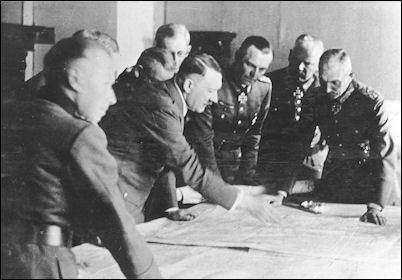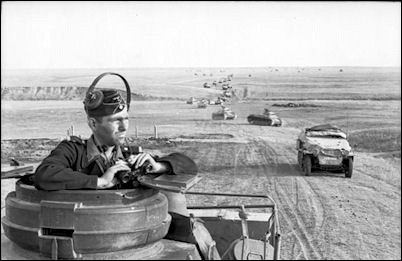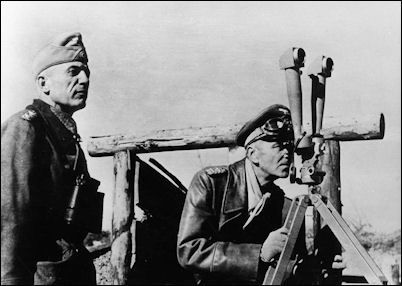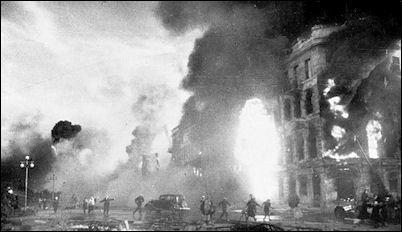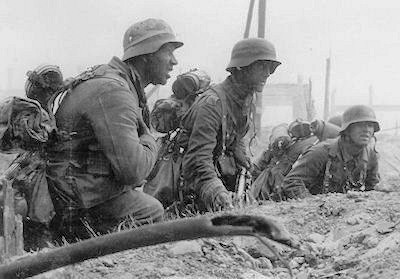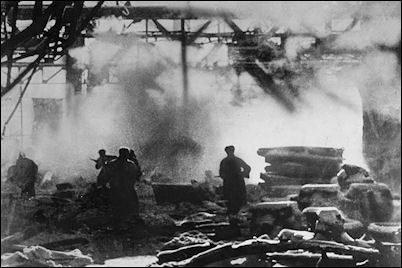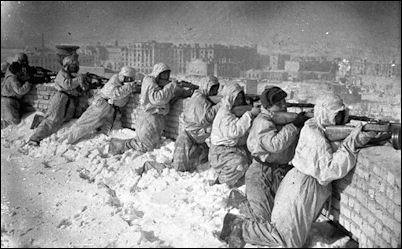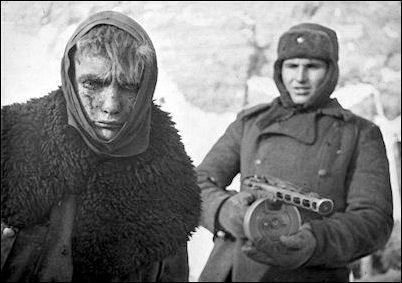![]()

Catastrophe at Stalingrad
The German Army never fully recovered from the beating it took in Russia around Moscow and elsewhere during the winter of 1941-42 when it suffered over a million casualties. For a time, the entire Eastern Front had teetered on the verge of collapse as division upon division of well-equipped Russians materialized seemingly out of nowhere and attacked.
Reacting to the debacle, Hitler assumed personal day-to-day operational command of the Army, brushing aside some of the world’s finest military experts, the same generals who had invented Blitzkrieg and engineered the lightning-fast victories over Poland and France. In their place, Hitler poured over the maps himself and made vital strategic decisions alone.
One of the men nearest to him throughout much of the war, General Alfred Jodl, Chief of Operations at OKW, reflected on the Führer's style: "If there is anything that clearly demonstrates the revolutionary character of Hitler's method of [military] leadership, it is that he did not concede to his military working staff, the OKW, and within it, the Operations Staff, the role of strategic adviser. All attempts I undertook in this direction failed. Hitler was willing to have a working staff that translated his decisions into orders which he would then issue as Supreme Commander of the Wehrmacht, but nothing more...He did not care to hear any other points of view; if they were even hinted at he would break into short-tempered fits of enraged agitation. Remarkable – and, for soldiers, incomprehensible – conflicts developed out of Hitler's almost mystical conviction of his own infallibility as leader of the nation and of the war."
Day-by-day Hitler took on more responsibility, directing the movements of individual divisions a thousand miles from his headquarters, based on information that was probably old by the time it reached him – especially bad news which was usually slow to reach the Führer. Additionally, Hitler had odd work habits, staying up till 4 a.m. or so every day, then sleeping till noon, when he would hold his first military conference of the day, needing to catch up on the morning's events. Other times, he was distracted by unrelated political and Nazi Party events. For example, at the very moment American troops were landing in North Africa, Hitler was away from his headquarters, attending the annual commemoration of the Beer Hall Putsch which had occurred back in 1923.
And there were, for Hitler the commander, some deeper flaws as German Field Marshal Erich von Manstein observed: "He was a man who saw fighting only in terms of the utmost brutality. His way of thinking conformed more to a mental picture of masses of the enemy bleeding to death before our lines than to the conception of a subtle fencer who knows how to make an occasional step backwards in order to lunge for the decisive thrust. For the art of war he substituted a brutal force which, as he saw it, was guaranteed maximum effectiveness by the will-power behind it.... Despite the pains Hitler took to stress his own former status as a frontline soldier, I still never had the feeling that his heart belonged to the fighting troops. Losses, as far as he was concerned, were merely figures which reduced fighting power. They are unlikely to have seriously disturbed him as a human being."
Now, in the late spring of 1942, as the muddy roads and fields finally dried out in Russia, Hitler steered the German Army into the region of southern Russia known as the Caucasus. Moscow would be left as-is for the time being. His new strategy was to grab the expansive oil fields in the Caucasus which fueled Russia’s war machine, and seize Stalingrad, the region’s major rail junction and industrial center, located along the Volga River. Conquering the city named after Soviet leader Josef Stalin, in addition to the oil fields, would be a fatal blow to Russia, Hitler believed.
But from the onset, the problem was a shortage of manpower. There simply were not enough available men of military age in Germany to make up for the losses already experienced in Russia. Therefore Hitler pressed his allies and coerced Nazi satellite states into sending him fresh troops. As a result, the Wehrmacht was boosted by the addition of 52 non-German divisions recruited from allies Italy and Spain and from satellites Hungary, Romania, and Slovakia. Their arrival in Russia made up for the shortage, but also made the German generals uneasy, realizing they were now dangerously reliant on troops with questionable training and skills, whose steadfastness and loyalty under fire remained to be seen.
Despite their concerns, Hitler's offensive, which he named Operation Blue, got off to a good start. Army Group B made steady eastward progress toward Stalingrad while Army Group A headed for the oil fields in the Caucasus. But it was almost too easy. On closer look, German field commanders realized that Russian battle tactics had changed. Instead of stubbornly standing their ground and inviting encirclement, the Red Army had adopted a new strategy, the fighting retreat, to minimize losses and draw the Germans ever deeper into Russia, thereby stretching already-overtaxed supply lines to the breaking point. And it worked. The big Panzer tanks, which burned a gallon of fuel per mile, now had to stop and turn off their motors, just to wait for the fuel trucks to catch up, while the infantry sat around waiting for food and ammunition.
By mid-summer, as the two army groups and their 700 tanks inched toward the oil fields and Stalingrad, the worsening supply situation, combined with the Wehrmacht's already limited manpower in the region necessitated a critical decision – which of the two main objectives should be achieved first?
Without hesitation, Hitler decided to go for the oil fields. And so he directed Fourth Panzer Army southward away from Stalingrad to aid First Panzer Army which was already approaching the oil fields. But several days later, upon further reflection, now realizing the Russians had left Stalingrad virtually undefended, the Führer changed his mind and decided to turn Fourth Panzer Army completely around and send it northward, back toward Stalingrad.
But it took some time for Fourth Panzer Army to wheel itself around, thereby giving the Russians sufficient time to set up strong defensive positions south of Stalingrad to obstruct its northward advance. Regardless, Hitler ordered the attack on Stalingrad to proceed, and at the same time, ordered the oil fields to be taken. He had changed his mind again. Both objectives were now to be taken simultaneously.
German field commanders in Russia and members of the Army High Command were utterly dismayed. It seemed like the Moscow nightmare was about to be repeated. It was a reoccurrence of the long-standing, fundamental disagreement they had with Hitler – pick one target and attack it with overwhelming force – whereas Hitler preferred a piecemeal approach toward multiple targets to satisfy his broader ambitions.
Senior strategists urged the Führer to take Stalingrad first using all available resources, then go for the oil fields.
A year earlier, Hitler had ignored their advice regarding Moscow. Now he spurned their advice about Stalingrad, maintaining just as he had a year ago, that the Russian Army would be defeated if only they followed his plan.
Two of his most senior officers, General Halder, Chief of the Army General Staff, and Field Marshal List, Commander of Army Group A in the Caucasus, openly criticized that plan. Hitler responded by sacking both men and took over List's post himself, assuming direct command of all the armies in the Caucasus.
For the main assault on Stalingrad, Hitler chose the pride of the Wehrmacht, its Sixth Army, commanded by General Friedrich Paulus. By mid-September, after rolling through the Russian outer defenses, Sixth Army entered the confines of the city. But this brought big problems. German armored commanders and their troops were used to fighting in Russia's wide open spaces which allowed for effective maneuvering of tanks and motorized infantry. Battle conditions in Stalingrad were exactly the opposite – a maze of city streets and multi-story buildings.
Even worse, Stalingrad was now a pile of rubble. Prior to invading the city, the Germans had tried to weaken Russian resistance via massive aerial and artillery bombardments. But this only created a jumble of blocked streets and broken cement, serving as very good cover for the thousands of Russian infantrymen now waiting to confront the Germans.
Under such conditions the Battle of Stalingrad quickly degenerated into a hand-to-hand street fight in which the Germans paid with blood for every piece of ground they gained. A German lieutenant on the scene wrote: “The street is no longer measured by meters but by corpses…Stalingrad is no longer a town. By day it is an enormous cloud of burning, blinding smoke; it is a vast furnace lit by the reflection of the flames. And when night arrives, one of those scorching, howling, bleeding nights, the dogs plunge into the Volga and swim desperately to gain the other bank. The nights of Stalingrad are a terror for them. Animals flee this hell; the hardest stones cannot bear it for long; only men endure.”
With German casualties piling up at a rate of 20,000 men a day, Hitler pulled divisions from his outer defenses in the region and sent them in one-by-one. Meanwhile, Soviet leader Josef Stalin plunged a million soldiers into the city, telling them: “You can no longer retreat…There is only one road, the road that leads forward. Stalingrad will be saved by you, or wiped out with you.”
Hitler had truly met his match in Stalin – a man like himself who saw fighting only in terms of the utmost brutality.
As November began amid the cold and snow of an early Russian winter, German troops at Stalingrad pressed harder than ever to finish the job. Along the outskirts of the city, they pushed forward to the banks of the Volga River, cutting off all Russian supply routes into Stalingrad. Inside the city, German infantrymen mounted a supreme effort to crush the last pockets of Russian infantry in their midst. To the German people, Hitler confidently announced the city, now ninety percent occupied, would fall at any moment.
And then the Russians struck back.
It began at dawn on Thursday, November 19, 1942, amid a raging blizzard as thirteen Russian armies led by Marshal Georgi Zhukov blasted thinly held German rear positions miles away from the city, attacking simultaneously from the north and south.
By sending so many rear units one-by-one into Stalingrad, Hitler had seriously eroded his outer sectors, leaving them to be held by mostly non-German troops. Marshal Zhukov had observed this and planned the entire counter-offensive to exploit this weakness. Now the worst fears of the German generals were realized as their shaky Romanian, Hungarian and Italian allies swiftly caved in under the weight of the Russian attack. In just three days, Russian troops from the north and south blasted their way through the crumbling lines and linked up, thereby encircling and trapping the entire Sixth Army inside Stalingrad.
Hitler's new Chief of the Army General Staff, General Kurt Zeitzler, pleaded with the Führer to allow Sixth Army to attempt a breakout. But Hitler just hollered at him, “I won’t go back from the Volga!”
Instead, Hitler's plan was to supply his besieged army, some 20 German divisions, by air drops while relief troops led by Field Marshal Manstein fought their toward Stalingrad from the south.
But the plan was doomed from the start. Despite boasts by Göring that his Luftwaffe could pull it off, the supply planes were mostly grounded by bad weather. And when they did fly, Russian anti-aircraft guns and fighter planes blasted them out of the sky. As a result, only ten-percent of the needed supplies ever reached the troops. Meanwhile, Manstein’s troops only got to within thirty miles of the city and had to pull back or risk being surrounded themselves.
As the weather worsened, thousands of wounded, starving German infantrymen in Stalingrad froze to death amid subzero temperatures. General Zeitzler now pleaded with Hitler to let the remnants of Sixth Army attempt a breakout to the south to possibly link up with Manstein. He told Hitler of the appalling conditions.
But Hitler was unfazed. Stalingrad was to be held at all costs.
By now, the Russians had assembled seven armies to crush the Germans in Stalingrad. But before launching their attack, they offered a last minute chance to avoid the onslaught. On Friday, January 8, 1943, three Russians carrying a white flag presented surrender terms. However, they were reluctantly turned down by General Paulus, acting on Hitler's direct order. As a result, two days later, the Russians blasted the remaining Germans with five thousand artillery guns followed a week later by a massive infantry assault.
Once more the battle degenerated into a hand-to-hand street fight. This time the Russians paid with blood for every piece of ground they regained. But time was running out for Sixth Army. Food and ammunition supplies were critically low and the exhausted troops had been reduced to two narrow pockets in Stalingrad. On January 24th, the Russians offered another chance for surrender. This time Paulus sent a personal plea to Hitler: “Army requests immediate permission to surrender in order to save lives of remaining troops.”
Hitler responded: “Surrender is forbidden. Sixth Army will hold their position to the last man and the last round and by their heroic endurance will make an unforgettable contribution toward the establishment of a defensive front and the salvation of the Western World.”
Hitler followed this by bestowing over a hundred field promotions, hoping it would inspire Paulus and his command staff to go down in a blaze of glory. Paulus himself was elevated to Field Marshal by Hitler, knowing that no German Field Marshal had ever been captured alive.
But Paulus had other ideas. As Russian infantrymen approached Sixth Army’s command bunker, the cellar of a wrecked department store, Field Marshal Paulus and his surviving staff officers simply came out and quietly surrendered, ignoring Hitler’s order that they fight to the last man, as well as his implied desire that they commit suicide rather than capitulate. Thus the Battle of Stalingrad ended on a sullen, anticlimactic note, Sunday, January 31, 1943, ten years and one day after Hitler had come to power in Germany.
Out of an original force of 285,000 soldiers comprising Sixth Army, 165,000 had died in Stalingrad, while some 29,000 wounded had been air lifted out. The 91,000 survivors, including 24 generals and 2,500 officers, hobbled off in the snow to begin years of captivity in Russian POW camps in bitter cold Siberia. Only five thousand would survive the ordeal and return home, as the Russians, aware of how their men were faring in German hands, dished out the same treatment.
Russian casualties at Stalingrad are estimated at a million dead, including nearly all of the men Stalin had committed to fend off the initial attack.
After his surrender, an embittered Paulus turned against Hitler and Nazism. He collaborated with the Russians, forming a National Committee for Free Germany and made radio broadcasts from Moscow urging German troops to give up fighting for Hitler.
The refusal of Paulus to die honorably in battle, or by his own hand had enraged Hitler, who exclaimed: “How can one be so cowardly? I don’t understand it…What is life? Life is the Nation. The individual must die anyway. Beyond the life of the individual is the life of the Nation…So many people have had to die, and then a man like that besmirches the heroism of so many others at the last minute. He could have freed himself from all sorrow and ascended into eternity and national immortality, but he prefers to go to Moscow!”
On Wednesday, February 3, 1943, a special radio announcement informed the German people they had lost the Battle of Stalingrad. The news had a devastating impact on morale, casting an undeniable shadow of doubt on the Führer personally, and the future of Nazi Germany itself. A secret opinion survey taken shortly afterward by the Nazi intelligence service reported: “People ask, above all, why Stalingrad was not evacuated or relieved, and how it is possible, only a few months ago, to describe the military situation as secure? Fearing that an unfavorable end to the war is now possible, many compatriots are seriously thinking about the consequences of defeat.”
For Adolf Hitler and his most fanatical supporters, the military situation, although dire, was only part of the story. They were now fully engaged in another entirely different campaign – one they now considered equal in importance to the war, and here they were succeeding – the Final Solution of the Jewish problem.
Copyright © 2010 The History Place™ All Rights Reserved
![]()
NEXT SECTION - The Final Solution
The Defeat of Hitler Index
The History Place Main Index Page
Terms of use: Private home/school non-commercial, non-Internet re-usage only is allowed of any text, graphics, photos, audio clips, other electronic files or materials from The History Place.
